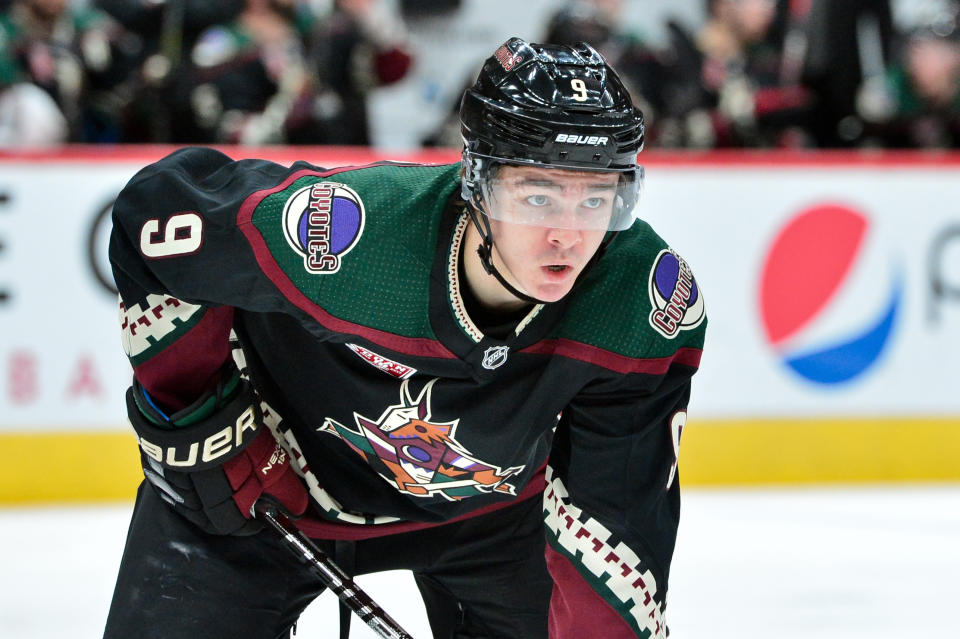Coyotes bet big on another young player, but will it pay off?

Not that you’d know it based on reputation, but the Coyotes are basically a cap team this year.
That’s thanks in part to having Marian Hossa on the books, but even without him they’d be in the $75 million range in terms of cap obligations. They’re paying big money to more players than you might expect; Oliver Ekman-Larsson, Phil Kessel, Derek Stepan, Nick Schmaltz, Alex Goligoski, and Nik Hjalmarsson all make at least $5 million against the cap. Carl Soderberg, Christian Dvorak, Jacob Chychrun, and Antti Raanta are just a bit under that mark as well.
Only one of those deals (Soderberg’s) comes off the books after this season, and another just got added to the pile: Earlier this week, Arizona locked up Clayton Keller for eight years at a $7.15 million AAV.
The decision on that contract was odd to say the least.
On the one hand, it’s totally understandable that any team would want to get out in front of a potentially protracted RFA negotiation for a high-end draft pick we’ve seen this summer in places like Columbus, Boston, Calgary and, of course, Toronto. To lock up a talented young player you believe in a year before his ELC expires makes sense in that regard.
On the other hand, the timing doesn’t make a ton of sense. Even if you want to go by scoring numbers (which you shouldn’t), Keller is coming off a down season, his second full year in the league. Despite a very slight uptick in ice time, he scored about 40 percent fewer goals and 28 percent fewer points, all while taking fewer shots in the same number of games. He had less of an impact on the power play but saw his 5-on-5 production in particular plummet. This is not the kind of “next step” you want to see from a 20-year-old taken seventh overall.
There is a legitimate argument to be made that things just didn’t work alongside Alex Galchenyuk (traded away in the Kessel deal) like they did with Derek Stepan. That’s a clear downgrade in linemate, and maybe the thinking is you bump him back up to play with Stepan and Kessel this year, or give him a run-out with Nick Schmaltz, who ran at nearly a point a game after his trade to Arizona, and before his season ended in December.
Nonetheless, $7.15 million is a huge bet for a guy who has shown himself to be pretty good and certainly promising, but not the kind of needle-mover you’d expect. For the kind of money he’s locked in for now, you’d expect him to be the kind of versatile forward who produces with anyone. And while he’s young, and a $7.15-million AAV isn’t what it used to be in terms of cap share, we just haven’t seen that from him yet.
He’ll likely start next season somewhere in the 30-40 range in terms of forward cap hits, so the Coyotes are saying, “This is basically a first-line player,” as of next season. And the thing is: We just haven’t seen that kind of consistency or quality in his game. Yeah, he had a 60-plus-point rookie season but he got a lot of very comfortable minutes on a very bad team that could put him in a position to produce. To his credit, he did, but there’s more to hockey than just scoring a good amount, and his relative numbers even in his much-better rookie year don’t inspire a lot of confidence.
The thinking on this deal seems to be the same one applied to the contracts for Chychrun, Schmaltz, and Dvorak: “We’re maybe paying a little more than they’re worth from ages 21 to 23, but we’ll be getting a great deal on these guys by year for the rest of the contract.”
Chychrun and Dvorak’s six-year deals, and Schmaltz’s seven-year contract all begin this season. Of those three, only Schmaltz has had a season that was undeniably impressive and mostly free of caveats, but then again, that season was spent alongside Patrick Kane, which helps.
They’ve all been in the league a couple years, at least, and we’ve yet to see any of them really have a big season independent of other factors. This is also true of Keller.
One has to wonder how much of this is the Coyotes trying to get out in front of a more expensive deal if Keller has a huge season in the last year of his ELC. No matter what line they put him on, he’s going to have talent around him, so the idea of a bounce-back to 60, 70, maybe even 80 points isn’t that unrealistic.
But let’s say he plays the full 82 and comes in near a point a game. That makes the down season a blip, scoring-wise, rather than the most recent data point. But how much more does a 21-year-old command in that situation versus what he already signed for? An extra $750,000? Maybe $1.5 million at the outside? Once you get Brad Richardson off the books next summer, that’s all the money you need freed up.
All these deals — to Keller now and Chychrun, Schmaltz, and Dvorak before — come across an awful lot like a team trying to over-project its young talented players’ capabilities, much as it did Ekman-Larsson’s when his oversized new deal was agreed.
These are all likely to be good players, yes, but good enough to live up to those contracts? Probably not.
Ryan Lambert is a Yahoo! Sports hockey columnist. His email is here and his Twitter is here.
All stats/salary info via Natural Stat Trick, Evolving Hockey, Hockey Reference, CapFriendly and Corsica unless noted.
More NHL coverage on Yahoo Sports



